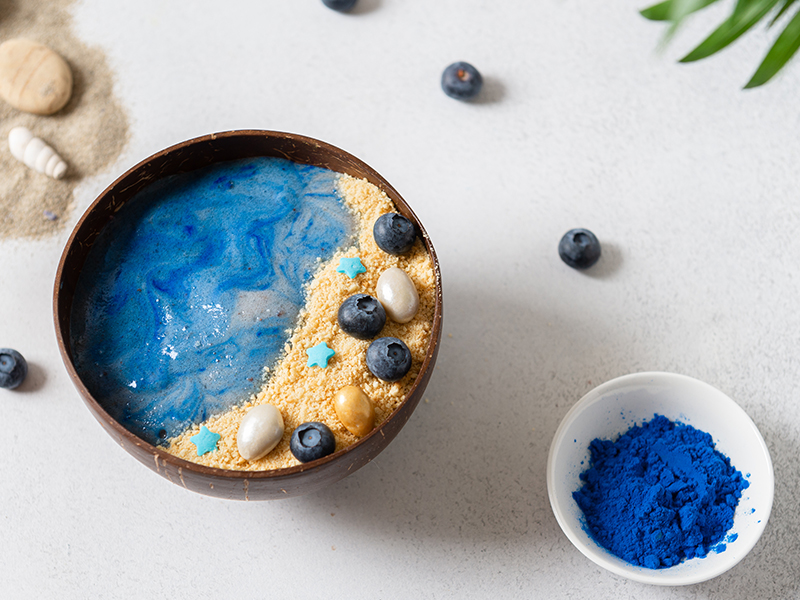
A guide to colouring foods, and blue spirulina as a potential source of colouring foods
It is often said that we eat with our eyes, making colour one of the most important factors for judging the quality of a food product.
Colouring food dates back centuries; a technique used by our ancestors to make morsels more appealing and enhance its perceived quality. For example, the characteristic yellow hue of rice was obtained by adding saffron. By the end of the 19th century, in the USA and Europe, the use of colour additives in the food industry was an ingrained habit with popular products such as ketchup, mustard and sodas featuring artificial colourants like cochineal (E 120), tartrazine (E 102) and caramel IV (E 150d), respectively on their labels. The use of synthetic dyes rapidly increased due to their lower costs, ease of production, and greater colouring strength and stability compared to natural-derived additives. However, with time, safety concerns mounted and artificial colourants became a hotly debated topic.1
What are colouring foods?
Colouring foods simply refers to food with colouring properties; they are usually derived from vegetables, fruits and edible plants that are naturally rich in pigments, such as carrots, pumpkins and blueberries.2
They are manufactured using non-chemical (enzymatic) and physical processes to extract the colouring pigments from the raw materials. These processes include washing, chopping, pressing, filtering, separating, concentrating, pasteurising and drying, wherein water is used as the preferred processing solvent.2 With these physical processes, the colouring pigments are not selectively extracted from the source material, so the colouring foods retain their inherent characteristics such as flavour, as well as their protein, sugar and lipid contents.3
Typically, colouring foods are in the form of colour-intensive viscous concentrates or powders. Since colouring foods are still food and can be consumed as such, they are labelled as ingredients and there are no dosage restrictions in a food product.
Additive food colours vs. colouring foods
Although ‘food colour’ (synthetic or natural) and ‘colouring foods’ have similar sounding names, they are different under EU regulation. Within Regulation (EC) No. 1333/2008, food colours are classified as food additives, while colouring foods are not, since they are, by definition, “normally consumed as food in itself” or “normally used as a characteristic ingredient of food”.2,4
Minimising colour degradation
When consumers purchase a product, they expect the colour and flavour to be consistent throughout its shelf life, but providing shelf-stable products with vibrant colours and tasty flavours is a big challenge.
Despite the benefits of using colouring foods as substitutes for synthetic dyes, these ingredients exhibit lower stabilities in a food product as compared to the latter, which can negatively influence the organoleptic properties of the final product. The stability of vegetable-, fruit- and flower-based pigments is dependent on several factors, including food matrix, temperature, pigment chemical structure, pH, water content, oxygen and light, to name a few.
Food matrix
As colouring foods still contain other raw material components, their addition may impact the chemical and physical properties of the food being coloured. In confectionery, for example, the inherent acids of a fruit or vegetable concentrate may induce sugar inversion and make the product sticky.3 Thus, the amount of colouring foods used should depend on the type of food application.
Moreover, the type of food matrix influences how the natural pigment is incorporated and stabilised in a product. For example, due to their lipophilic nature, carotenoids must be emulsified in water in order to colour beverage products. The pigment is dispersed in an oil phase, which is then subjected to homogenisation to obtain an oil-in-water emulsion stabilised by different emulsifiers. Further, to avoid oxidation in the food matrix, antioxidants such as tocopherols are added during the oil phase of the beverage emulsion.6
Temperature
Regarding temperature, pasteurisation or sterilisation is one of the most common measures applied to ensure microbial safety, but this thermal processing step might result in colour degradation. For example, the bright red colour of anthocyanins is replaced by a darker red colour.7 A strategy to mitigate these negative effects is to optimise the temperature profile of the heating process and to choose an appropriate raw material.8 It is known that the chemical structure of anthocyanins affects the thermostability of the pigment. Anthocyanins derived from purple sweet potatoes and black carrots are more stable during processing than strawberry anthocyanins, due to the presence of acylated anthocyanins that contain additional acyl groups (eg, phenolic acids) attached in their structure conferring stability.9
Oxygen
The presence of oxygen either during processing or in the packaging negatively affects the stability of red (anthocyanins, betalains, lycopene), yellow orange (carotene) and green (chlorophyll) pigments. Oxygen removal during and after food processing is not straightforward, yet industry has developed different strategies to minimise oxidative reactions. For example, during production it is common to use closed systems to avoid the incorporation of air or else use nitrogen gas to prevent oxidation.10
The type of packaging material used for food products also influences oxygen levels during shelf life. Except for glass or metal cans, most packaging materials (eg, polyethylene terephthalate PET, high-density polyethylene) used in the beverages industry allow the diffusion of oxygen. To overcome this problem, the use of multilayer PET bottles or oxygen scavengers in the packaging material have been shown to limit colour degradation during storage.11
Light
Light also plays an important role in colour loss and other degradative reactions for specific natural pigments such as carotenoids, which can easily be degraded due to their conjugated double bond systems.12 Although many carotenoid‑coloured foods and beverages are displayed in store shelves exposed to artificial light, light exposure is minimised by use of non-transparent packaging (eg, metal cans, cartons, tinted bottles) or by putting sleeves in the bottles as part of labelling material.

Blue spirulina as a source of colouring foods
Algae, both micro and macro (seaweed), have promising potential as colouring foods due to the variety of colour pigments they contain. And, as colouring foods, non-purified aqueous extract of the algae can already be used to impart colour (eg, blue spirulina(phycocyanin) for blue colour) to food products such as confections, ice cream, beverages and yoghurts,13 and does not require an E-number label inside the EU.
Blue spirulina(phycocyanin) is derived from Spirulina and is currently the only blue pigment of plant origin. Blue spirulina(phycocyanin) was allowed to be used by the US FDA back in 2013 and has now been expanded into a number of food products such as beverages, confectionery and pasta. In Europe, blue spirulina(phycocyanin) is also used as a colouring food.
Currently, most food giants such as Mars and Nestlé use blue spirulina(phycocyanin) as a source of blue in their products. Apart from being a colour-rich food, blue spirulina(phycocyanin) is also a very nutritious and functional ingredient, which is very much in line with the current trend of plant protein, plant-based and clean labels.
Blue spirulina(phycocyanin) is usually a blue pellet or powder, a protein-binding pigment, and therefore has the same properties as protein, with an isoelectric point of 3.4. Soluble in water but insoluble in alcohols and oils. Unstable to heat, light and acids. Stable under weak acidity and neutrality (pH 4.5-8), precipitates when acidic (pH 4.2), strong alkali to decolourisation.
References
- Mcavoy S. (2014). “Global regulations of food colours. The Manufacturing Confectionery”. 77-87
- Stich E. (2016). Food color and coloring food: quality, differentiation and regulatory requirements in the European Union and the United States. In Handbook on Natural Pigments in Food and Beverages (pp. 3-27). Woodhead Publishing
- Ghidouche S, Rey B, Michel M, Galaffu N. (2013). A Rapid tool for the stability assessment of natural food colours. Food chemistry, 139(1-4), 978-985
- Melchor SR, Di Mario A. (2014). Legislative update. Agro FOOD Industry Hi Tech, 25, 3
- Reinhart A. (2014). Colouring Foods versus Food Colours: Guidance Notes on the Classification of Food Extracts with Colouring Properties. European Food and Feed Law Review, 9(2), 105-113
- Mesnier X, Gregory C, Fança-Berthon P, Boukobza F, Bily A. (2014). Heat and light colour stability of beverages coloured with a natural carotene emulsion: Effect of synthetic versus natural wate- soluble antioxidants. Food research international, 65, 149-155
- Teribia N, Buvé C, Bonerz D, Aschoff J, Hendrickx M, Van Loey A. (2021). Impact of processing and storage conditions on color stability of strawberry puree: The role of PPO reactions revisited. Journal of Food Engineering, 294, 110402
- Fernández-López JA, Angosto JM, Giménez PJ, León G. (2013). Thermal stability of selected natural red extracts used as food colorants. Plant Foods for Human Nutrition, 68(1), 11-17
- Assous MTM, Abdel-Hady MM, Medany GM. (2014). Evaluation of red pigment extracted from purple carrots and its utilization as antioxidant and natural food colorants. Annals of Agricultural Sciences, 59(1), 1-7
- Cortez R, Luna‐Vital DA, Margulis D, Gonzalez de Mejia E. (2017). Natural pigments: stabilization methods of anthocyanins for food applications. Comprehensive Reviews in Food Science and Food Safety, 16(1), 180-198
- Buvé C, Kebede BT, De Batselier C, Carrillo C, Pham HT, Hendrickx M, Van Loey A. (2018). Kinetics of colour changes in pasteurised strawberry juice during storage. Journal of Food Engineering, 216, 42-51
- Limbo S, Torri L, Piergiovanni L. (2007). Light-induced changes in an aqueous β-carotene system stored under halogen and fluorescent lamps, affected by two oxygen partial pressures. Journal of agricultural and food chemistry, 55(13), 5238-5245
- FDA. U.S. Food and Drug. Summary of Colour Additives for Use in the United States in Foods, Drugs, Cosmetics and Medical Devices. Available online: https://www.fda.gov/industry/color-additive-inventories/summary-color-additives-use-united-states-foods-drugs-cosmetics-and-medical-device (accessed on 31 Dec 2020)

